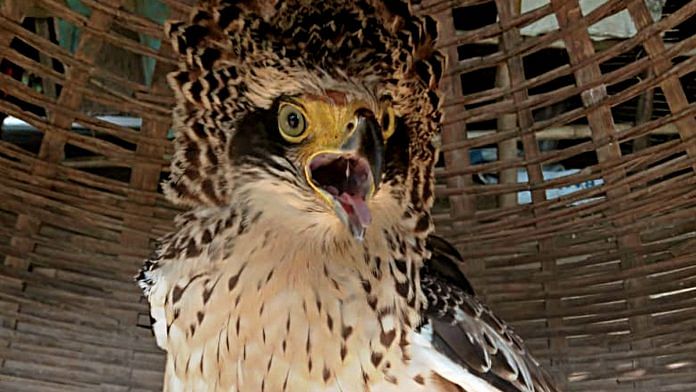Bengaluru: The forest department in Odisha’s Mayurbhanj district has rescued and released a rare eagle, tentatively officially identified as a Philippine eagle.
“We have rescued a rare species of eagle in the Baripada forest division,” Swayam Mallick, divisional forest officer (DFO) Baripada, told ANI. “We have released it in the Similipal Tiger Reserve.”
“Preliminary identification shows it to be a Philippine eagle,” he added.
The eagle was rescued Friday at the Baripada forest and was released after a medical check-up.
Final details on the eagle’s species are still awaited. However, experts have pointed out that the bird seen in the ANI video is likely a crested serpent eagle, and not a Philippine eagle based on its features and location.
‘Doesn’t look like Philippine Eagle’
Speaking to ThePrint, Raja Bandi, a bird watcher and citizen science coordinator at IISER-Tirupati, said, “This doesn’t look like a Philippine Eagle.”
He added, “It is most likely a juvenile crested serpent eagle. The ear converts are prominently blackish and the head is prominently white with white underparts. The bird has that distinctive white nuchal crest around its neck.”
The nuchal crest is a series of feathers or markings that extend from the chest to the back of an animal’s head. The harpy-like crown feathers, seen in the video above, form a part of it. These feathers are normally folded and not visible, but are displayed prominently when a bird is excited.
“From the video, the bird was visibly excited, probably because it felt threatened or challenged. So the crest was in an erect position,” he explained.

Prominent Indian bird photographer Aravind A.M. agrees.
“The chances of this being a harpy eagle or a Philippine eagle are practically zero,” he told ThePrint. “Philippine eagles are endemic to the country of Philippines. This is a juvenile crested serpent eagle. They are found commonly in India.”
The crested serpent eagle is a commonly found bird of prey in India and is not classified as ‘Endangered’ or even ‘Threatened’. It is classified as ‘Least Concern’.
As their name suggests, they feed on snakes and other reptiles like lizards. They are brown in colour as adults, but as immature juveniles, they display prominent white colouring. They are medium-sized and found in tropical forests.
The Philippine eagle, however, is the largest eagle in the world in terms of wingspan and body length. Just like its similar looking cousin, harpy eagle, which is the heaviest eagle in the world, the Philippine eagle also feeds on monkeys. Both species are often nicknamed ‘monkey-eating eagle’.
The Philippine eagle is critically endangered with an estimated 400 pairs alone remaining in the wild. The main reason for its decline is loss of habitat due to deforestation. It’s the national bird of Philippines and killing one is punishable by up to 12 years under the Philippine law.
Also read: Human beings are pushing larger animals like rhinos & elephants to extinction faster



